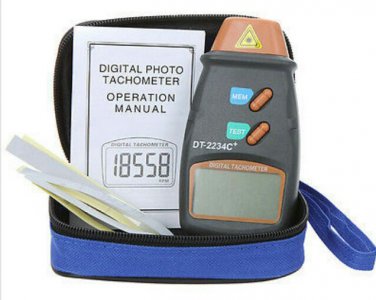- Joined
- Oct 20, 2014
- Messages
- 159
Ingredients:
frequency meter (DMM/multimeter, oscilloscope, guitar tuner, computer/phone with microphone and audio software)
resistor (~100k)
capacitor (~0.1uf)
battery (9V)
various wires/probe leads/alligator clips
piece of scotch tape
way to multiply two numbers
How it works:
You are creating an electrical square wave pulse train from the rotation of whatever object you want to measure.
Then you measure the frequency of that pulse train with your frequency meter.
The object must be metal. (Unless you instead make an AUDIBLE square wave like cards in bicycle spokes! And then use guitar tuner or phone/computer with audio analyzer)
You connect things so that you touch one probe of the meter to the machine body (lathe ways, mill bed, etc..).
The other probe gets held gently against the spinning spindle of the machine.
And you place a piece of scotch tape around 1/2 the circumference of the spindle. So the meter will measure battery voltage half the time, and nothing the other half. There is your square wave.
ACTUALLY. That wont work. Because the meter probably wont recognize battery voltage and then "nothing" (60hz noise) as a square wave.
So you need to "pull down" the meter probe to battery negative (assuming you connected positive to machine).
Thats what the resistor is for. The resistor goes across the meter probes.
OOPS..still doesnt work. Too much noise. Thats what the capacitor is for. Place it across the meter probes too. Now we've filtered out some high frequency crap.
Ta-da! My Atlas 10F was spinning at 9.8Hz. Multiple by 60 and you have rpm. 588 rpm! Wow alot slower than I thought.
REALITY CHECK:
Different meters have different requirements for frequency measurement signals. For instance some may not measure frequencies as low as 10hz, or some may need the voltage to be above 10V or below 5V or who knows what. Gotta check your manual and adjust this circuit as needed.
Lotsa wires all over and holding a probe against a spinning lathe chuck is dangerous. So dont attempt any of this unless you want to play the "stuff flying around the machine shop" game.
You may need a different resistor and/or cap value. For me 100k and 0.1uF worked great with a steady frequency reading. Careful you dont filter your signal right off to zero!
Dont event THINK about using mains voltage instead of a battery!
Dont leave the battery connected. Dont use too small a resistor or you'll kill your battery and maybe the resistor too.
Now you can check all your pulley speeds once and know exactly what they are! Im not sure where some of my pulleys came from on the countershaft and motor, so its nice to verify everything.
If you dont have a meter which reads frequency, or doesnt read frequency this low, you have some options:
-Instead of putting one long strip of tape around 50% of the spindle, make a bunch of little squares, so now you have a much higher frequency, which maybe your meter can read.
-If your meter doesnt measure frequency, perhaps you could read the pulses as a voltage and if you know your meters averaging/response you could interpret the voltage that way.
-You could make an integrator and average the pulses into a steady voltage which you read with the meter. The voltage would be proportional to the frequency but you would need to know the duty cycle I think. That or carefully make sure the tape is exactly 50% of the spindle circumference.
-You could use an oscilloscope, even an old analog one.
-If you REALLY want to scrounge, you could put a TON of scotch tape "pulses" on the spindle, as many as you can fit, which should put the frequency up into the audio range, and then you could try measuring it using a guitar tuner, or perhaps a computer with software that lets you measure frequency or look at the waveform and figure it out. For machine that has only fixed pulley speeds, you only need to do this once, so even if its a mess and pain it works out. But for something that has an infinitely variable speed, you may want to make a tidier setup that uses a meter you can always see.
HAVE FUN! A MILLION WAYS TO SKIN THIS CAT!









frequency meter (DMM/multimeter, oscilloscope, guitar tuner, computer/phone with microphone and audio software)
resistor (~100k)
capacitor (~0.1uf)
battery (9V)
various wires/probe leads/alligator clips
piece of scotch tape
way to multiply two numbers
How it works:
You are creating an electrical square wave pulse train from the rotation of whatever object you want to measure.
Then you measure the frequency of that pulse train with your frequency meter.
The object must be metal. (Unless you instead make an AUDIBLE square wave like cards in bicycle spokes! And then use guitar tuner or phone/computer with audio analyzer)
You connect things so that you touch one probe of the meter to the machine body (lathe ways, mill bed, etc..).
The other probe gets held gently against the spinning spindle of the machine.
And you place a piece of scotch tape around 1/2 the circumference of the spindle. So the meter will measure battery voltage half the time, and nothing the other half. There is your square wave.
ACTUALLY. That wont work. Because the meter probably wont recognize battery voltage and then "nothing" (60hz noise) as a square wave.
So you need to "pull down" the meter probe to battery negative (assuming you connected positive to machine).
Thats what the resistor is for. The resistor goes across the meter probes.
OOPS..still doesnt work. Too much noise. Thats what the capacitor is for. Place it across the meter probes too. Now we've filtered out some high frequency crap.
Ta-da! My Atlas 10F was spinning at 9.8Hz. Multiple by 60 and you have rpm. 588 rpm! Wow alot slower than I thought.
REALITY CHECK:
Different meters have different requirements for frequency measurement signals. For instance some may not measure frequencies as low as 10hz, or some may need the voltage to be above 10V or below 5V or who knows what. Gotta check your manual and adjust this circuit as needed.
Lotsa wires all over and holding a probe against a spinning lathe chuck is dangerous. So dont attempt any of this unless you want to play the "stuff flying around the machine shop" game.
You may need a different resistor and/or cap value. For me 100k and 0.1uF worked great with a steady frequency reading. Careful you dont filter your signal right off to zero!
Dont event THINK about using mains voltage instead of a battery!
Dont leave the battery connected. Dont use too small a resistor or you'll kill your battery and maybe the resistor too.
Now you can check all your pulley speeds once and know exactly what they are! Im not sure where some of my pulleys came from on the countershaft and motor, so its nice to verify everything.
If you dont have a meter which reads frequency, or doesnt read frequency this low, you have some options:
-Instead of putting one long strip of tape around 50% of the spindle, make a bunch of little squares, so now you have a much higher frequency, which maybe your meter can read.
-If your meter doesnt measure frequency, perhaps you could read the pulses as a voltage and if you know your meters averaging/response you could interpret the voltage that way.
-You could make an integrator and average the pulses into a steady voltage which you read with the meter. The voltage would be proportional to the frequency but you would need to know the duty cycle I think. That or carefully make sure the tape is exactly 50% of the spindle circumference.
-You could use an oscilloscope, even an old analog one.
-If you REALLY want to scrounge, you could put a TON of scotch tape "pulses" on the spindle, as many as you can fit, which should put the frequency up into the audio range, and then you could try measuring it using a guitar tuner, or perhaps a computer with software that lets you measure frequency or look at the waveform and figure it out. For machine that has only fixed pulley speeds, you only need to do this once, so even if its a mess and pain it works out. But for something that has an infinitely variable speed, you may want to make a tidier setup that uses a meter you can always see.
HAVE FUN! A MILLION WAYS TO SKIN THIS CAT!









Last edited:


